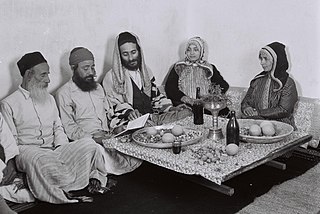
The history of Yemen describes the cultures, events, and peoples of what is one of the oldest centers of civilization in the Near East. Its relatively fertile land and adequate rainfall in a moister climate helped sustain a stable population, a feature recognized by the ancient Greek geographer Ptolemy, who described Yemen as Eudaimon Arabia meaning "fortunate Arabia" or "Happy Arabia". Yemenis had developed the South Arabian alphabet by the 12th to 8th centuries BC, which explains why most historians date all of the ancient Yemeni kingdoms to that era.
The constitution of Iran states that the country is an Islamic republic; it specifies Twelver Ja’afari Shia Islam as the official state religion.

Yemenite Jews, also known as Yemeni Jews or Teimanim, are Jews who live, or once lived, in Yemen, and their descendants maintaining their customs. Between June 1949 and September 1950, the overwhelming majority of the country's Jewish population immigrated to Israel in Operation Magic Carpet. After several waves of persecution, the vast majority of Yemenite Jews now live in Israel, while smaller communities live in the United States and elsewhere. As of 2022, Levi Marhabi is the last Jew in Yemen.
Sectarianism is a debated concept. Some scholars and journalists define it as pre-existing fixed communal categories in society, and use it to explain political, cultural, or religious conflicts between groups. Others conceive of sectarianism as a set of social practices where daily life is organised on the basis of communal norms and rules that individuals strategically use and transcend. This definition highlights the co-constitutive aspect of sectarianism and people’s agency, as opposed to understanding sectarianism as being fixed and incompatible communal boundaries.

Islam in Yemen dates back to about 630AD, when it was introduced by Ali who finalized the conquest of it when Muhammad was still alive. It was during this period that the mosques in Janad and the Great Mosque of Sana'a were built. Yemenis are divided into two principal Islamic religious groups: 65% Sunni and 35% Shia. Others put the numbers of Shias at 30%. The denominations are as follows: 65% primarily of the Shafi'i and other orders of Sunni Islam. 33% of the Zaidi order of Shia Islam, 2% of the Ja'fari and Tayyibi Ismaili orders of Shia Islam. Yemen is home to the Sulaymani Bohra community, a subdivision of Tayyibi Mustali Ismailism. The Sunnis are predominantly in the south and southeast. The Zaidis are predominantly in the north and northwest whilst the Jafaris are in the main centres of the North such as Sana'a and Ma'rib. There are mixed communities in the larger cities.

Islam is the majority religion in Azerbaijan, but the country is considered to be the most secular in the Muslim world. Estimates include 97.3% and 99.2% of the population identifying as Muslim. Of these, a majority belong to the Shia branch (55-65%), while a significant minority (35-45%) are Sunni. Traditionally, the differences between these two branches of Islam have not been sharply defined in Azerbaijan.

Operation Magic Carpet is a widely known nickname for Operation On Wings of Eagles, an operation between June 1949 and September 1950 that brought 49,000 Yemenite Jews to the new state of Israel. During its course, the overwhelming majority of Yemenite Jews – some 47,000 from Yemen, 1,500 from Aden, as well as 500 from Djibouti and Eritrea and some 2,000 Jews from Saudi Arabia – were airlifted to Israel. British and American transport planes made some 380 flights from Aden.

Christianity is a minority religion in Yemen. The Yemeni constitution mentions religious liberty. There are three churches in Aden.

The history of the Jews in the Arabian Peninsula dates back to Biblical times. The Arabian Peninsula is defined as including the present-day countries of Bahrain, Kuwait, Oman, Qatar, Saudi Arabia, United Arab Emirates and Yemen politically and parts of Iraq and Jordan geographically.
Religion in Iran has been shaped by multiple religions and sects over the course of the country's history. Zoroastrianism was the main followed religion during the Achaemenid Empire, Parthian Empire, and Sasanian Empire. Another Iranian religion known as Manichaeanism was present in Iran during this period. Jewish and Christian communities thrived, especially in the territories of northwestern, western, and southern Iran—mainly Caucasian Albania, Asoristan, Persian Armenia, and Caucasian Iberia. A significant number of Iranian peoples also adhered to Buddhism in what was then eastern Iran, such as the regions of Bactria and Sogdia.
The Constitution of Yemen provides for freedom of religion, and the Government generally respected this right in practice; however, there were some restrictions. The Constitution declares that Islam is the state religion, and that Shari'a is the source of all legislation. Government policy continued to contribute to the generally free practice of religion; however, there were some restrictions. Muslims and followers of religious groups other than Islam are free to worship according to their beliefs, but the Government prohibits conversion from Islam and the proselytization of Muslims. Although relations among religious groups continued to contribute to religious freedom, there were some reports of societal abuses and discrimination based on religious belief or practice. There were isolated attacks on Jews and some prominent Zaydi Muslims felt targeted by government entities for their religious affiliation. Government military reengagement in the Saada governorate caused political, tribal, and religious tensions to reemerge in January 2007, following the third military clash with rebels associated with the al-Houthi family, who adhere to the Zaydi school of Shi'a Islam.
Freedom of religion in Azerbaijan is substantially curtailed. The Azerbaijan government, which follows a strictly secular and anti-religious ideology, represses all religions.

The Houthi movement, officially known as Ansar Allah, is a Shia Islamist political and military organization that emerged from Yemen in the 1990s. It is predominantly made up of Zaidi Shias, with their namesake leadership being drawn largely from the Houthi tribe.
Islam is the majority and official religion in the United Arab Emirates, professed by 74.5% of the population as of 2020. 63.3% are Sunni, 6.7% are Shia, while 4.4% follow another branch of Islam. The Al Nahyan and Al Maktoum ruling families adhere to the Maliki school of jurisprudence. Many followers of the Hanbali school are found in Sharjah, Umm al-Quwain, Ras al-Khaimah and Ajman. Their followers include the Al Qasimi ruling family. The other main religions present in the country include Christianity (12.9%), Hinduism (6.2%), and Buddhism (3.2%). Zoroastrians, Druze, Baha'i, Judaism, and Sikhism are also practiced by some non-nationals. 1.3% of the population is agnostic.
The main religion in Morocco is Sunni Islam, which is also the state religion of the country. Officially, 99% of the population are Muslim, and virtually all of those are Sunni. The second-largest religion in the country is Christianity, but most Christians in Morocco are foreigners. There is a community of the Baháʼí Faith. Only a fraction of the former number of Maghrebi Jews have remained in the country, many having moved to Israel.

Yemenite Jews in Israel are immigrants and descendants of the immigrants of the Yemenite Jewish communities, who now reside within the state of Israel. They number around 400,000 in the wider definition. Between June 1949 and September 1950, the overwhelming majority of Yemen and Aden's Jewish population was transported to Israel in Operation Magic Carpet.

In the early years before the immigration to Israel, the Jewish community of Saada numbered around 1000 people.

Shia Islam in Yemen is practiced by a substantial minority of the population, with the vast majority of Shia Muslims in Yemen being Zaydi, while a minority are Twelver and Isma'ili. Sunni Muslims make up 65% percent of Yemen, while 35% of the country are Shia Muslims. These Shia Muslims are predominantly concentrated in the northwestern regions of the country, including the capital and major cities that are some of the most densely populated areas of Yemen.
The status of religious freedom in Asia varies from country to country. States can differ based on whether or not they guarantee equal treatment under law for followers of different religions, whether they establish a state religion, the extent to which religious organizations operating within the country are policed, and the extent to which religious law is used as a basis for the country's legal code.
Levi Salem Musa Marhabi is a Yemenite Orthodox Jew and the last known Jew living in Yemen. He was imprisoned by Iran-backed Houthi militants in 2016 for allegedly assisting in smuggling a Torah scroll out of the country. Held in a prison in Sanaa, Marhabi has received harsh treatment from his detainers, with an emergence of reports of torture and deteriorating health conditions. In 2019, a Yemeni court ordered his release; however, the Houthis continued to detain him.















